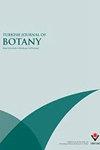中度干旱对芦苇水生和沿海种群叶芽状细胞的影响
IF 1.5
4区 生物学
Q3 PLANT SCIENCES
引用次数: 1
摘要
研究了生长在乌克兰基辅第聂伯罗河威尼斯海峡岸边的芦苇(Phragmites australis)水生和陆生种群的叶片,以确定球状细胞在植物抵抗中度土壤干旱的机制中的作用。在干旱和强烈的阳光下,球状(运动)细胞参与叶子的扭曲和折叠。采用光镜法、细胞化学法、激光共聚焦显微镜法和生物化学法对南菖蒲水生种群和陆生种群叶片的球状细胞进行了研究。通过对南芥叶片球状细胞结构的比较分析,发现不同生长地点的南芥叶片球状细胞结构存在显著差异。球状细胞的数量、大小和面积以及多糖含量的差异显示出明显的表型可塑性。细胞化学和激光共聚焦显微镜对水陆生态型南菖蒲球状细胞细胞壁多糖的研究表明,在自然中度干旱的土壤条件下,土壤水分的减少导致球状细胞外壁木质素和丁香基单脂醇含量的增加,同时导致外、内细胞壁纤维素和胼胝质含量的减少。所获得的数据表明,所研究的球状细胞标志可以作为群体植物耐受性的标志,这些群体植物具有卷曲叶片的能力,可以在中等干旱条件下保持最佳的水分平衡。本文章由计算机程序翻译,如有差异,请以英文原文为准。
Effects of Moderate Drought on Leaf Bulliform Cells of Aquatic and Coastal Population of Phragmites australis
: Studying leaves of aquatic and terrestrial populations of Phragmites australis grown on the bank of the Venetian strait of the Dnipro River in Kyiv (Ukraine) for establishing the role of bulliform cells in the mechanisms of plant resistance to moderate soil drought were studied. Bulliform (motor) cells participate in the twisting and folding of leaves during drought and strong sunlight. The study of bulliform cells in the leaves of the aquatic and terrestrial populations of P. australis was carried out using the methods of light microscopy, cytochemical methods, laser confocal microscopy, and biochemical methods. The comparative analysis of the structure of bulliform cells of leaves of P. australis has shown significant differences depending on plant growth location. The differences in the number, size, and area of bulliform cells and also polysaccharide content showed clear phenotypical plasticity. Cytochemical and laser confocal microscopic studies of polysaccharides of cell walls in bulliform cells of aquatic and terrestrial ecotypes of P. australis showed that a decrease in soil moisture in a natural moderate drought of soil led to an increase in lignin and syringyl monolignol content in the outer walls of bulliform cells and also to a decrease in cellulose and callose content in outer and inner cell walls. The obtained data shows that the studied signs of bulliform cells can be markers of tolerance for population plants that have the ability to curl leaves for the preservation of optimal water balance in moderate drought.
求助全文
通过发布文献求助,成功后即可免费获取论文全文。
去求助
来源期刊

Turkish Journal of Botany
PLANT SCIENCES-
CiteScore
2.90
自引率
5.60%
发文量
31
审稿时长
6-12 weeks
期刊介绍:
The Turkish Journal of Botany is published electronically 6 times a year by the Scientific and Technological Research Council of Turkey (TÜBİTAK) and accepts manuscripts (in English) covering all areas of plant biology (including genetics, evolution, systematics, structure, function, development, diversity, conservation biology, biogeography, paleobotany, ontogeny, functional morphology, ecology, reproductive biology, and pollination biology), all levels of organisation (molecular to ecosystem), and all plant groups and allied organisms (algae, fungi, and lichens). Authors are required to frame their research questions and discuss their results in terms of major questions in plant biology. In general, papers that are too narrowly focused, purely descriptive, or broad surveys, or that contain only preliminary data or natural history, will not be considered (*).
The following types of article will be considered:
1. Research articles: Original research in various fields of botany will be evaluated as research articles.
2. Research notes: These include articles such as preliminary notes on a study or manuscripts on the morphological, anatomical, cytological, physiological, biochemical, and other properties of plant, algae, lichen and fungi species.
3. Reviews: Reviews of recent developments, improvements, discoveries, and ideas in various fields of botany.
4. Letters to the editor: These include opinions, comments relating to the publishing policy of the Turkish Journal of Botany, news, and suggestions. Letters should not exceed one journal page.
(*) 1. Raw floristic lists (of algae, lichens, fungi, or plants), species descriptions, chorological studies, and plant sociology studies without any additional independent approaches.
2. Comparative morphology and anatomy studies (that do not cover a family, tribe, subtribe, genus, subgenus, section, subsection, or species complexes with taxonomical problems) without one or more independent additional approaches such as phylogenetical, micromorphological, chromosomal and anatomical analyses.
3. Revisions of family, tribe, genus, subgenus, section, subsection, or species complexes without any original outputs such as taxonomical status changes, IUCN categories, and phenological and ecological analyses.
4. New taxa of all plants without any additional independent approaches such as phylogenetical, ecological, chromosomal, chorological and correlational analyses in addition to a detailed macro- and micro-morphological descriptions with quality field and microscopic illustrations of taxonomically important structures and identification key in the taxonomic group.
New records of all plants without any additional independent approaches such as phylogenetical, ecological, chromosomal, chorological and correlational analyses in addition to a detailed macro- and micro-morphological descriptions with quality field and microscopic illustrations of taxonomically important structures and identification key in the taxonomic group may be accepted for peer review if they contain 3 or more new records or taxonomical status update, such as lectotypification, new combinations, transfers, revivals and synonyms.
5. New taxa of algae, lichens, and fungi without any additional independent approaches such as phylogenetical, ecological, chromosomal, chorological and correlational analyses in addition to a detailed macro- and micro-morphological descriptions with quality field and microscopic illustrations of taxonomically important structures and identification key in the taxonomic group.
New records of algae, lichens, and fungi without any additional independent approaches such as phylogenetical, ecological, chromosomal, chorological and correlational analyses in addition to a detailed macro- and micro-morphological descriptions with quality field and microscopic illustrations of taxonomically important structures and identification key in the taxonomic group may be accepted for peer review if they contain 5 or more new records or taxonomical status update, such as lectotypification, new combinations, transfers, revivals and synonyms.
 求助内容:
求助内容: 应助结果提醒方式:
应助结果提醒方式:


